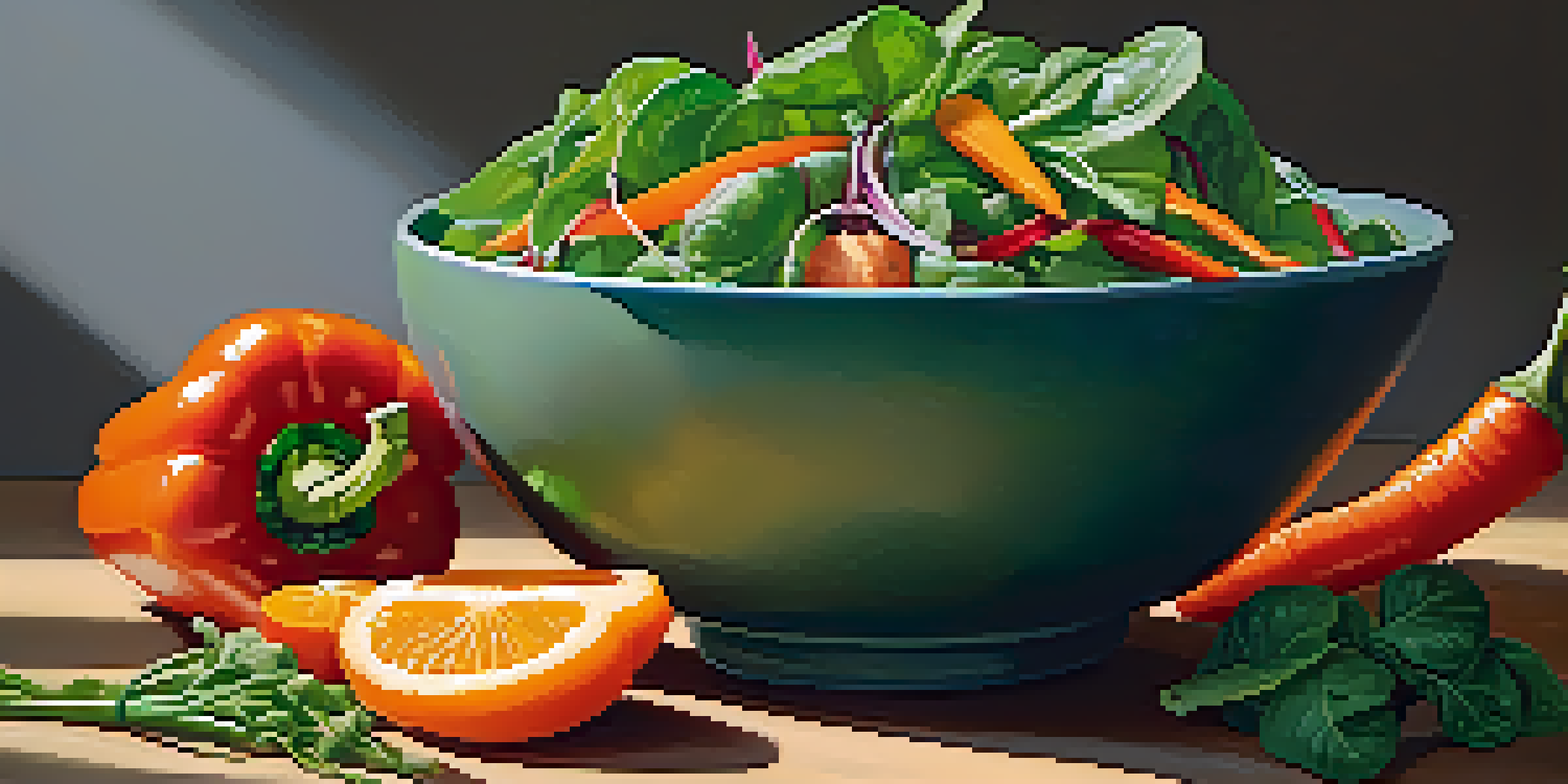The Benefits of Raw Foods for Kids: Nutrition Simplified

What Are Raw Foods and Why They Matter
Raw foods primarily include fruits, vegetables, nuts, and seeds that are unprocessed and uncooked. This means they retain all their natural nutrients and enzymes, making them a powerhouse of health benefits. For kids, this is particularly important as they are growing and need ample nutrition to support their development.
Let food be thy medicine and medicine be thy food.
Incorporating raw foods into your child's diet can help them develop healthy eating habits early on. Think of it like building a strong foundation for a house; the better the foundation, the sturdier the home. When children consume whole, raw foods, they are setting themselves up for a lifetime of health.
Moreover, raw foods are often more colorful and appealing to kids. Imagine a vibrant salad bursting with colors; it can make mealtime fun and encourage kids to explore new tastes and textures.
Boosting Nutrient Intake with Raw Foods
One of the most significant benefits of raw foods is their high nutrient content. Cooking can sometimes diminish the vitamins and minerals found in fruits and vegetables, but raw foods preserve these essential nutrients. For example, vitamin C, which is crucial for your child’s immune system, is often lost during cooking.

By including raw foods in their meals, kids can enjoy the full spectrum of nutrients that support their overall health. Picture a rainbow salad filled with spinach, carrots, and bell peppers; each color represents different vitamins and minerals necessary for growth and energy.
Raw Foods Boost Nutrient Intake
Raw foods retain essential vitamins and minerals that support children's growth and immune health.
Furthermore, raw foods are often rich in fiber, aiding digestion and helping kids feel full longer. This can be particularly beneficial in reducing cravings for sugary snacks, which are all too common in today’s diet.
Raw Foods Promote Healthy Digestion
Raw foods are naturally high in fiber, which is essential for a healthy digestive system. Fiber helps in moving food through the intestines and can prevent issues like constipation, a common problem among kids. Think of fiber as the broom that helps keep the digestive tract clean and functioning smoothly.
Eating raw food is the simplest and most effective way to cleanse the body and maintain health.
When kids eat plenty of raw fruits and vegetables, they are not only getting the fiber they need but also enzymes that help break down food. These enzymes can aid in digestion and nutrient absorption, making meals more effective in nourishing their growing bodies.
Incorporating raw foods into their diet can also introduce children to a variety of textures, promoting healthy chewing habits. This can be a fun experience, as they discover how crunchy carrots or juicy apples can make meals more enjoyable.
Supporting Immune Health with Raw Foods
A robust immune system is crucial for kids, especially during cold and flu season. Raw foods, packed with vitamins and antioxidants, can provide a significant boost to their immune defenses. Foods like bell peppers and citrus fruits are loaded with vitamin C, which is known to enhance immune function.
Moreover, many raw foods contain antioxidants that help fight off free radicals, which can harm cells and weaken the immune system. Imagine antioxidants as little warriors in your child's body, working diligently to keep them healthy.
Promotes Healthy Digestion
The high fiber content in raw foods aids digestion and helps prevent constipation in kids.
Encouraging kids to enjoy raw foods can also instill a sense of awareness about their health. When they understand that what they eat can impact how they feel, they may be more inclined to make healthier choices.
Encouraging Healthy Weight Management
Raw foods can play a significant role in helping kids maintain a healthy weight. Since they are often lower in calories but high in nutrients and fiber, raw foods can keep children feeling full without the excess calories. It's like filling a gas tank; you want to provide just the right amount to keep things running smoothly.
When kids enjoy raw fruits and vegetables as snacks, they are less likely to reach for processed, high-calorie options. For instance, swapping chips for crunchy cucumber slices or carrot sticks can make a big difference in their overall calorie intake.
Additionally, teaching children about the benefits of raw foods can empower them to make healthier food choices. As they become more aware of how different foods affect their bodies, they may naturally gravitate towards more nutritious options.
Enhancing Energy Levels with Raw Foods
Raw foods are often energy-dense, providing essential nutrients without the heaviness of processed foods. This can be particularly beneficial for active kids who need sustained energy throughout the day. Think of raw foods as clean fuel for their bodies, allowing them to run, jump, and play without feeling sluggish.
Fruits like bananas and apples are perfect snacks for a quick energy boost. They are easy to grab on the go and can help keep kids energized during school or playtime, unlike sugary snacks that can lead to energy crashes.
Encourages Healthy Eating Habits
Involving kids in meal prep and making raw foods visually appealing can inspire them to make healthier food choices.
Incorporating a variety of raw foods can help balance energy levels throughout the day. By choosing whole foods, kids can experience stable energy without the ups and downs associated with processed snacks.
Making Raw Foods Fun and Accessible for Kids
Getting kids excited about raw foods can be as simple as making it fun! Involve them in the kitchen by letting them help wash, peel, or chop fruits and vegetables. When kids have a hand in preparing their meals, they are often more eager to try what they've made.
Creating colorful and visually appealing dishes can also entice kids to dig in. Think about arranging a vibrant fruit platter or a rainbow veggie stick display; the more fun it looks, the more likely they are to enjoy it.

Lastly, consider incorporating raw foods into familiar recipes. For instance, adding fresh veggies to a wrap or blending fruits into a smoothie can make raw foods more approachable for picky eaters. The key is to keep experimenting until you find what sparks their interest.